ACT305 Corporate Accounting: AASB 10 & Consolidated Reporting
VerifiedAdded on 2023/06/04
|12
|2248
|460
Report
AI Summary
This report provides a comprehensive analysis of AASB 10, focusing on its application to consolidated financial statements and investment decisions. It examines various scenarios, including investments in subsidiaries, loans converted to equity, and jointly controlled entities. The report addresses the requirements for consolidation, non-controlling interests, and goodwill impairment. It also delves into specific accounting treatments for intercompany transactions, such as inventory adjustments, profit on sale of plant, and management fees. The analysis is supported by journal entries and acquisition analyses, offering a practical understanding of AASB 10's impact on financial reporting. This student contributed document is available on Desklib, where students can find various study resources.
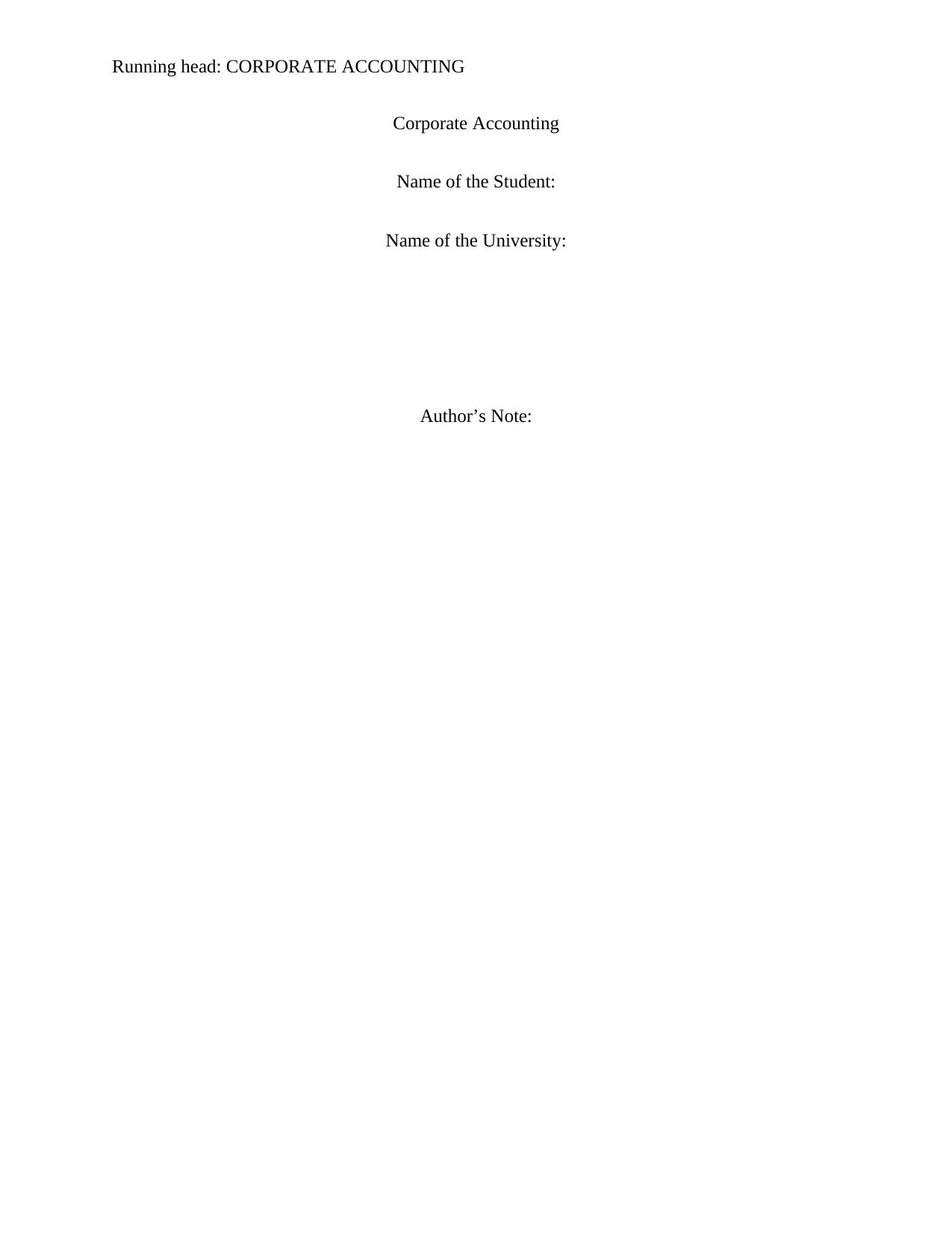
Running head: CORPORATE ACCOUNTING
Corporate Accounting
Name of the Student:
Name of the University:
Author’s Note:
Corporate Accounting
Name of the Student:
Name of the University:
Author’s Note:
Paraphrase This Document
Need a fresh take? Get an instant paraphrase of this document with our AI Paraphraser
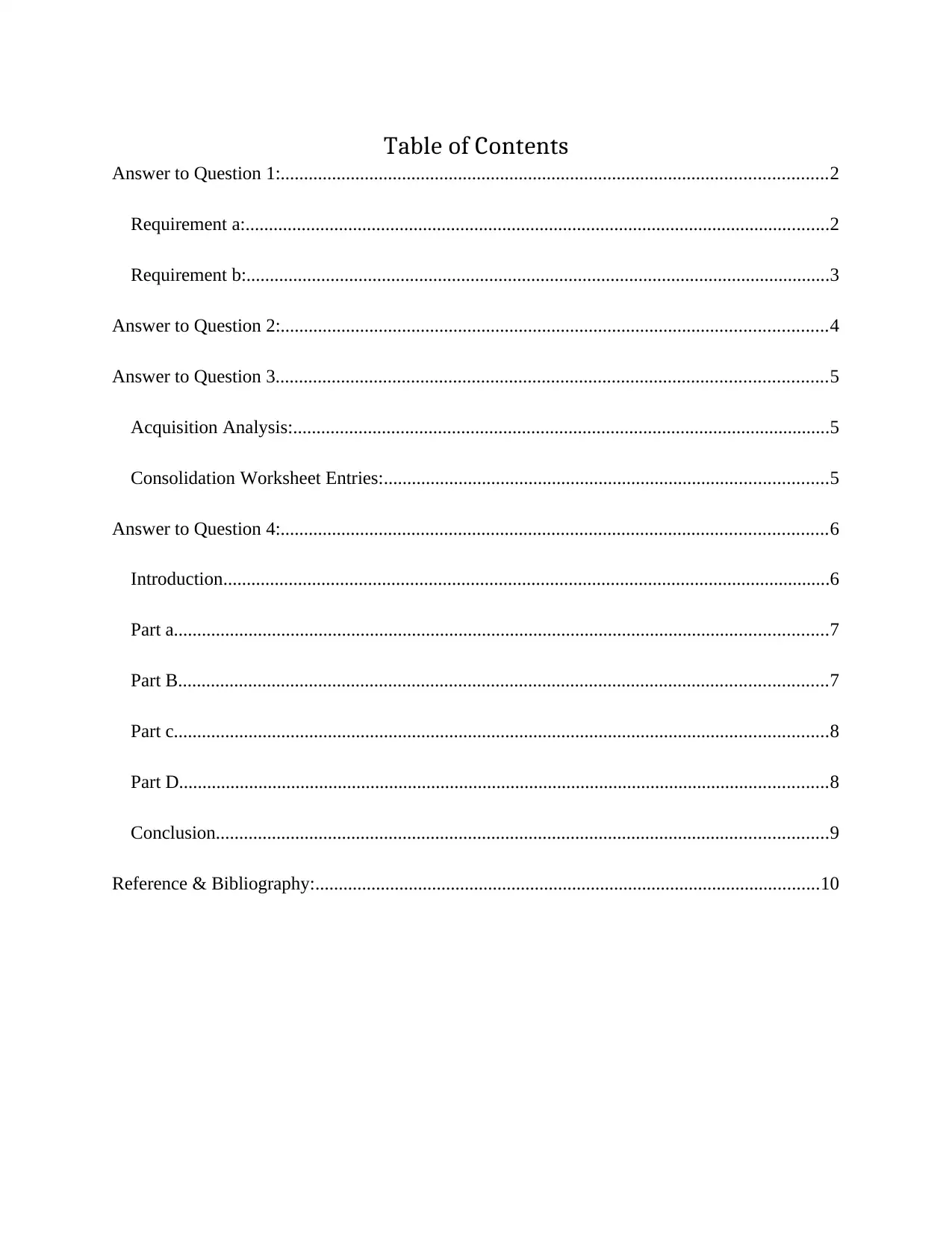
Table of Contents
Answer to Question 1:.....................................................................................................................2
Requirement a:.............................................................................................................................2
Requirement b:.............................................................................................................................3
Answer to Question 2:.....................................................................................................................4
Answer to Question 3......................................................................................................................5
Acquisition Analysis:...................................................................................................................5
Consolidation Worksheet Entries:...............................................................................................5
Answer to Question 4:.....................................................................................................................6
Introduction..................................................................................................................................6
Part a............................................................................................................................................7
Part B...........................................................................................................................................7
Part c............................................................................................................................................8
Part D...........................................................................................................................................8
Conclusion...................................................................................................................................9
Reference & Bibliography:............................................................................................................10
Answer to Question 1:.....................................................................................................................2
Requirement a:.............................................................................................................................2
Requirement b:.............................................................................................................................3
Answer to Question 2:.....................................................................................................................4
Answer to Question 3......................................................................................................................5
Acquisition Analysis:...................................................................................................................5
Consolidation Worksheet Entries:...............................................................................................5
Answer to Question 4:.....................................................................................................................6
Introduction..................................................................................................................................6
Part a............................................................................................................................................7
Part B...........................................................................................................................................7
Part c............................................................................................................................................8
Part D...........................................................................................................................................8
Conclusion...................................................................................................................................9
Reference & Bibliography:............................................................................................................10

Answer to Question 1:
Requirement a:
Dr. Cr.
Date Amount Amount
01-07-2017 Investment in Fry Ltd. Dr. $ 50,000.00
To, Cash at Bank $ 50,000.00
30-06-2018 Investment in Fry Ltd. Dr. $ 15,000.00
To, Share of Profit in Fry Ltd. $ 15,000.00
Cash at Bank Dr. $ 24,000.00
To, Investment in Fry Ltd. $ 24,000.00
30-06-2019 Investment in Fry Ltd. Dr. $ 13,500.00
To, Share of Profit in Fry Ltd. $ 13,500.00
Cash at Bank Dr. $ 4,500.00
To, Investment in Fry Ltd. $ 4,500.00
30-06-2020 Investment in Fry Ltd. Dr. $ 12,000.00
To, Share of Profit in Fry Ltd. $ 12,000.00
Cash at Bank Dr. $ 3,000.00
To, Investment in Fry Ltd. $ 3,000.00
In the books of Small Ltd.
Journal Entries
Particulars
Requirement a:
Dr. Cr.
Date Amount Amount
01-07-2017 Investment in Fry Ltd. Dr. $ 50,000.00
To, Cash at Bank $ 50,000.00
30-06-2018 Investment in Fry Ltd. Dr. $ 15,000.00
To, Share of Profit in Fry Ltd. $ 15,000.00
Cash at Bank Dr. $ 24,000.00
To, Investment in Fry Ltd. $ 24,000.00
30-06-2019 Investment in Fry Ltd. Dr. $ 13,500.00
To, Share of Profit in Fry Ltd. $ 13,500.00
Cash at Bank Dr. $ 4,500.00
To, Investment in Fry Ltd. $ 4,500.00
30-06-2020 Investment in Fry Ltd. Dr. $ 12,000.00
To, Share of Profit in Fry Ltd. $ 12,000.00
Cash at Bank Dr. $ 3,000.00
To, Investment in Fry Ltd. $ 3,000.00
In the books of Small Ltd.
Journal Entries
Particulars
⊘ This is a preview!⊘
Do you want full access?
Subscribe today to unlock all pages.

Trusted by 1+ million students worldwide

Requirement b:
Dr. Cr.
Date Amount Amount
01-07-2017 Investment in Fry Ltd. Dr. $ 50,000.00
To, Cash at Bank $ 50,000.00
30-06-2018 Equity Capital Dr. $ 9,000.00
Retained Profits (1/7/17) Dr. $ 36,000.00
Goodwill Dr. $ 5,000.00
To, Investment in Fry Ltd. $ 50,000.00
Equity Capital Dr. $ 21,000.00
Retained Profits (1/7/17) Dr. $ 84,000.00
To, NCI $ 1,05,000.00
Retained Profits (30/6/18) Dr. $ 35,000.00
To, NCI Share of Profit $ 35,000.00
Dividend Received Dr. $ 24,000.00
NCI Dr. $ 56,000.00
To, Dividend Paid $ 80,000.00
30-06-2019 Retained Profits (30/6/19) Dr. $ 31,500.00
To, NCI Share of Profit $ 31,500.00
Dividend Received Dr. $ 4,500.00
NCI Dr. $ 10,500.00
To, Dividend Paid $ 15,000.00
30-06-2020 Retained Profits (30/6/20) Dr. $ 28,000.00
To, NCI Share of Profit $ 28,000.00
Dividend Received Dr. $ 3,000.00
NCI Dr. $ 7,000.00
To, Dividend Paid $ 10,000.00
Particulars
In the books of Small Ltd.
Journal Entries
Dr. Cr.
Date Amount Amount
01-07-2017 Investment in Fry Ltd. Dr. $ 50,000.00
To, Cash at Bank $ 50,000.00
30-06-2018 Equity Capital Dr. $ 9,000.00
Retained Profits (1/7/17) Dr. $ 36,000.00
Goodwill Dr. $ 5,000.00
To, Investment in Fry Ltd. $ 50,000.00
Equity Capital Dr. $ 21,000.00
Retained Profits (1/7/17) Dr. $ 84,000.00
To, NCI $ 1,05,000.00
Retained Profits (30/6/18) Dr. $ 35,000.00
To, NCI Share of Profit $ 35,000.00
Dividend Received Dr. $ 24,000.00
NCI Dr. $ 56,000.00
To, Dividend Paid $ 80,000.00
30-06-2019 Retained Profits (30/6/19) Dr. $ 31,500.00
To, NCI Share of Profit $ 31,500.00
Dividend Received Dr. $ 4,500.00
NCI Dr. $ 10,500.00
To, Dividend Paid $ 15,000.00
30-06-2020 Retained Profits (30/6/20) Dr. $ 28,000.00
To, NCI Share of Profit $ 28,000.00
Dividend Received Dr. $ 3,000.00
NCI Dr. $ 7,000.00
To, Dividend Paid $ 10,000.00
Particulars
In the books of Small Ltd.
Journal Entries
Paraphrase This Document
Need a fresh take? Get an instant paraphrase of this document with our AI Paraphraser
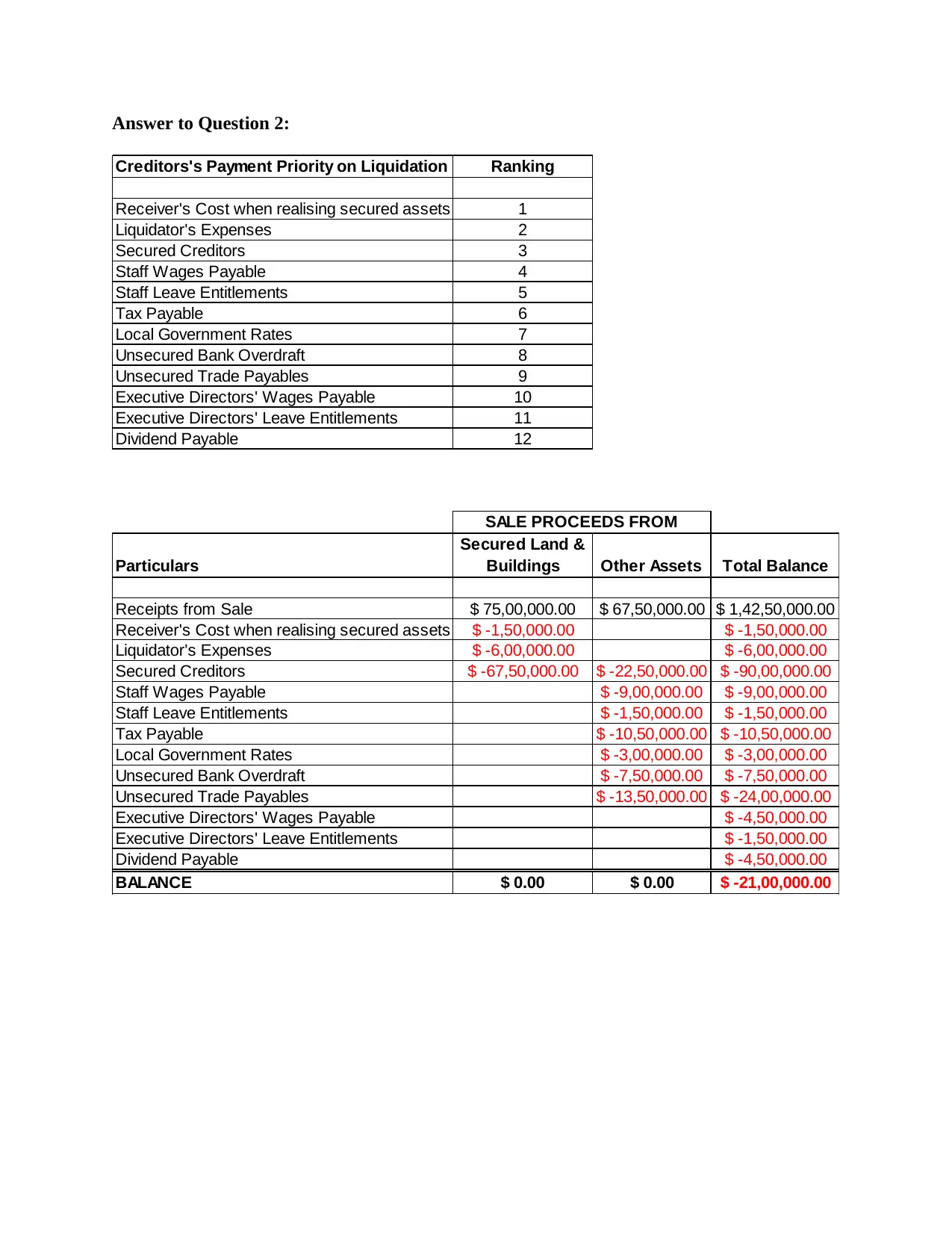
Answer to Question 2:
Creditors's Payment Priority on Liquidation Ranking
Receiver's Cost when realising secured assets 1
Liquidator's Expenses 2
Secured Creditors 3
Staff Wages Payable 4
Staff Leave Entitlements 5
Tax Payable 6
Local Government Rates 7
Unsecured Bank Overdraft 8
Unsecured Trade Payables 9
Executive Directors' Wages Payable 10
Executive Directors' Leave Entitlements 11
Dividend Payable 12
Particulars
Secured Land &
Buildings Other Assets Total Balance
Receipts from Sale $ 75,00,000.00 $ 67,50,000.00 $ 1,42,50,000.00
Receiver's Cost when realising secured assets $ -1,50,000.00 $ -1,50,000.00
Liquidator's Expenses $ -6,00,000.00 $ -6,00,000.00
Secured Creditors $ -67,50,000.00 $ -22,50,000.00 $ -90,00,000.00
Staff Wages Payable $ -9,00,000.00 $ -9,00,000.00
Staff Leave Entitlements $ -1,50,000.00 $ -1,50,000.00
Tax Payable $ -10,50,000.00 $ -10,50,000.00
Local Government Rates $ -3,00,000.00 $ -3,00,000.00
Unsecured Bank Overdraft $ -7,50,000.00 $ -7,50,000.00
Unsecured Trade Payables $ -13,50,000.00 $ -24,00,000.00
Executive Directors' Wages Payable $ -4,50,000.00
Executive Directors' Leave Entitlements $ -1,50,000.00
Dividend Payable $ -4,50,000.00
BALANCE $ 0.00 $ 0.00 $ -21,00,000.00
SALE PROCEEDS FROM
Creditors's Payment Priority on Liquidation Ranking
Receiver's Cost when realising secured assets 1
Liquidator's Expenses 2
Secured Creditors 3
Staff Wages Payable 4
Staff Leave Entitlements 5
Tax Payable 6
Local Government Rates 7
Unsecured Bank Overdraft 8
Unsecured Trade Payables 9
Executive Directors' Wages Payable 10
Executive Directors' Leave Entitlements 11
Dividend Payable 12
Particulars
Secured Land &
Buildings Other Assets Total Balance
Receipts from Sale $ 75,00,000.00 $ 67,50,000.00 $ 1,42,50,000.00
Receiver's Cost when realising secured assets $ -1,50,000.00 $ -1,50,000.00
Liquidator's Expenses $ -6,00,000.00 $ -6,00,000.00
Secured Creditors $ -67,50,000.00 $ -22,50,000.00 $ -90,00,000.00
Staff Wages Payable $ -9,00,000.00 $ -9,00,000.00
Staff Leave Entitlements $ -1,50,000.00 $ -1,50,000.00
Tax Payable $ -10,50,000.00 $ -10,50,000.00
Local Government Rates $ -3,00,000.00 $ -3,00,000.00
Unsecured Bank Overdraft $ -7,50,000.00 $ -7,50,000.00
Unsecured Trade Payables $ -13,50,000.00 $ -24,00,000.00
Executive Directors' Wages Payable $ -4,50,000.00
Executive Directors' Leave Entitlements $ -1,50,000.00
Dividend Payable $ -4,50,000.00
BALANCE $ 0.00 $ 0.00 $ -21,00,000.00
SALE PROCEEDS FROM
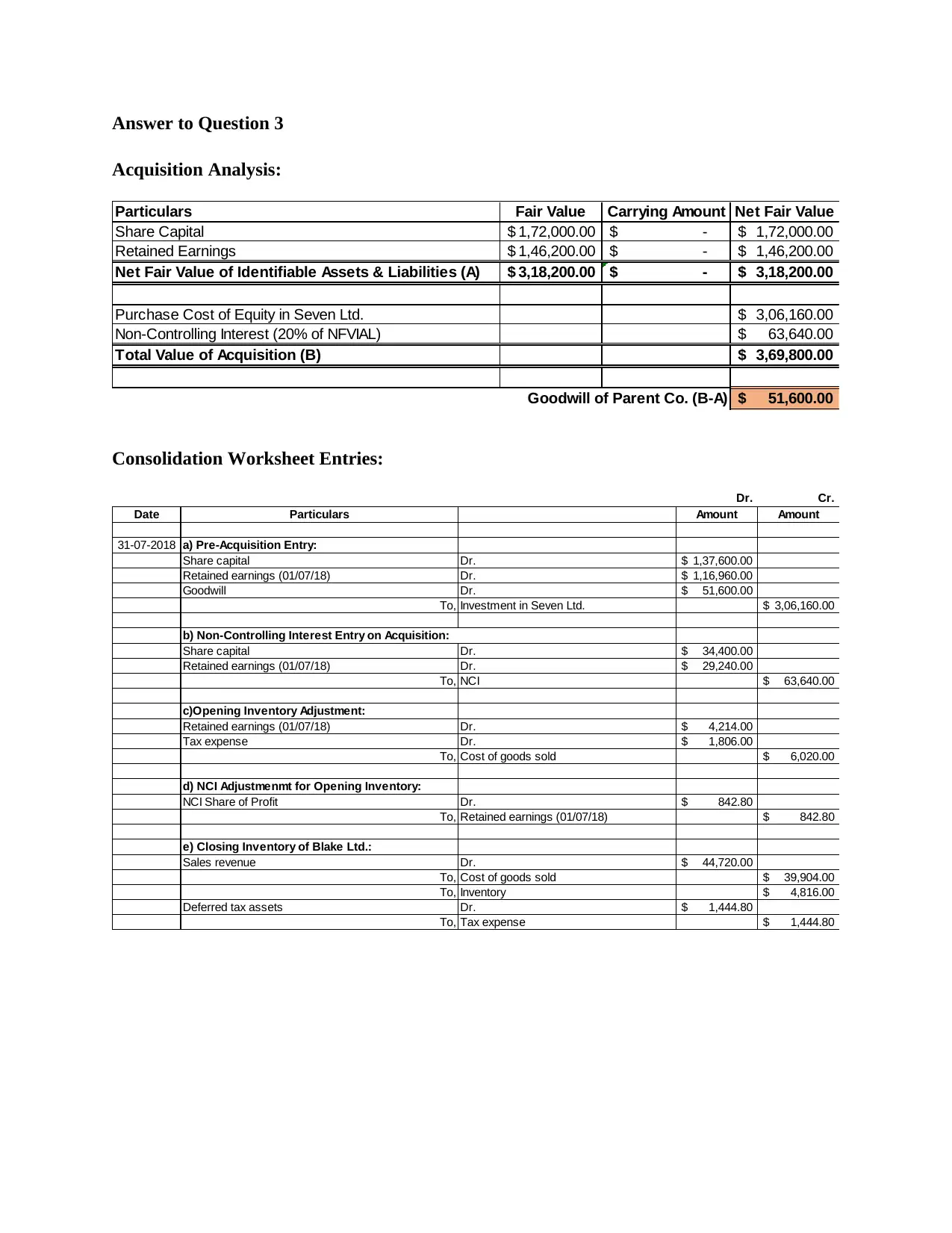
Answer to Question 3
Acquisition Analysis:
Particulars Fair Value Carrying Amount Net Fair Value
Share Capital 1,72,000.00$ -$ 1,72,000.00$
Retained Earnings 1,46,200.00$ -$ 1,46,200.00$
Net Fair Value of Identifiable Assets & Liabilities (A) 3,18,200.00$ -$ 3,18,200.00$
Purchase Cost of Equity in Seven Ltd. 3,06,160.00$
Non-Controlling Interest (20% of NFVIAL) 63,640.00$
Total Value of Acquisition (B) 3,69,800.00$
51,600.00$Goodwill of Parent Co. (B-A)
Consolidation Worksheet Entries:
Dr. Cr.
Date Particulars Amount Amount
31-07-2018 a) Pre-Acquisition Entry:
Share capital Dr. 1,37,600.00$
Retained earnings (01/07/18) Dr. 1,16,960.00$
Goodwill Dr. 51,600.00$
To, Investment in Seven Ltd. 3,06,160.00$
Share capital Dr. 34,400.00$
Retained earnings (01/07/18) Dr. 29,240.00$
To, NCI 63,640.00$
c)Opening Inventory Adjustment:
Retained earnings (01/07/18) Dr. 4,214.00$
Tax expense Dr. 1,806.00$
To, Cost of goods sold 6,020.00$
d) NCI Adjustmenmt for Opening Inventory:
NCI Share of Profit Dr. 842.80$
To, Retained earnings (01/07/18) 842.80$
e) Closing Inventory of Blake Ltd.:
Sales revenue Dr. 44,720.00$
To, Cost of goods sold 39,904.00$
To, Inventory 4,816.00$
Deferred tax assets Dr. 1,444.80$
To, Tax expense 1,444.80$
b) Non-Controlling Interest Entry on Acquisition:
Acquisition Analysis:
Particulars Fair Value Carrying Amount Net Fair Value
Share Capital 1,72,000.00$ -$ 1,72,000.00$
Retained Earnings 1,46,200.00$ -$ 1,46,200.00$
Net Fair Value of Identifiable Assets & Liabilities (A) 3,18,200.00$ -$ 3,18,200.00$
Purchase Cost of Equity in Seven Ltd. 3,06,160.00$
Non-Controlling Interest (20% of NFVIAL) 63,640.00$
Total Value of Acquisition (B) 3,69,800.00$
51,600.00$Goodwill of Parent Co. (B-A)
Consolidation Worksheet Entries:
Dr. Cr.
Date Particulars Amount Amount
31-07-2018 a) Pre-Acquisition Entry:
Share capital Dr. 1,37,600.00$
Retained earnings (01/07/18) Dr. 1,16,960.00$
Goodwill Dr. 51,600.00$
To, Investment in Seven Ltd. 3,06,160.00$
Share capital Dr. 34,400.00$
Retained earnings (01/07/18) Dr. 29,240.00$
To, NCI 63,640.00$
c)Opening Inventory Adjustment:
Retained earnings (01/07/18) Dr. 4,214.00$
Tax expense Dr. 1,806.00$
To, Cost of goods sold 6,020.00$
d) NCI Adjustmenmt for Opening Inventory:
NCI Share of Profit Dr. 842.80$
To, Retained earnings (01/07/18) 842.80$
e) Closing Inventory of Blake Ltd.:
Sales revenue Dr. 44,720.00$
To, Cost of goods sold 39,904.00$
To, Inventory 4,816.00$
Deferred tax assets Dr. 1,444.80$
To, Tax expense 1,444.80$
b) Non-Controlling Interest Entry on Acquisition:
⊘ This is a preview!⊘
Do you want full access?
Subscribe today to unlock all pages.

Trusted by 1+ million students worldwide
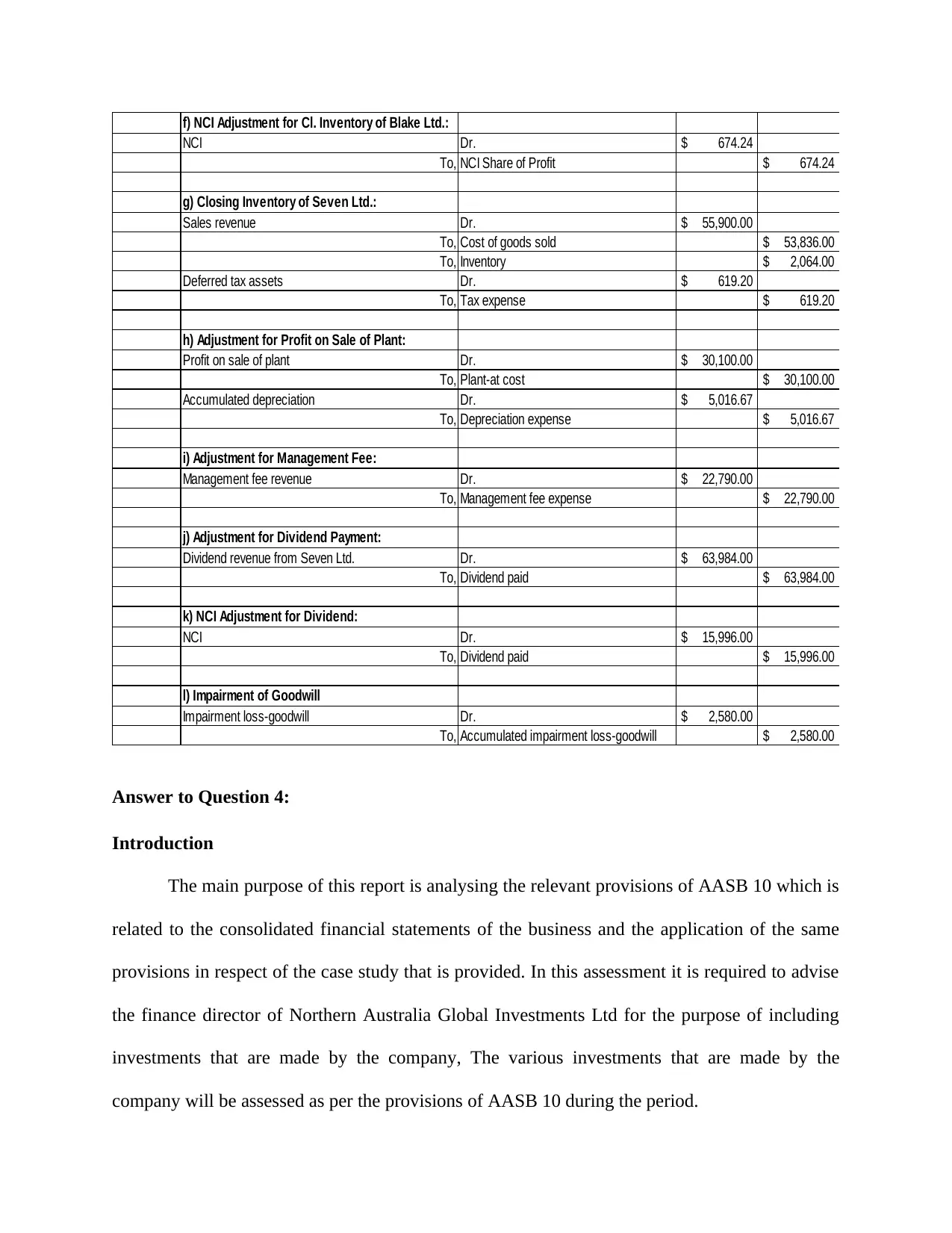
f) NCI Adjustment for Cl. Inventory of Blake Ltd.:
NCI Dr. 674.24$
To, NCI Share of Profit 674.24$
g) Closing Inventory of Seven Ltd.:
Sales revenue Dr. 55,900.00$
To, Cost of goods sold 53,836.00$
To, Inventory 2,064.00$
Deferred tax assets Dr. 619.20$
To, Tax expense 619.20$
h) Adjustment for Profit on Sale of Plant:
Profit on sale of plant Dr. 30,100.00$
To, Plant-at cost 30,100.00$
Accumulated depreciation Dr. 5,016.67$
To, Depreciation expense 5,016.67$
i) Adjustment for Management Fee:
Management fee revenue Dr. 22,790.00$
To, Management fee expense 22,790.00$
j) Adjustment for Dividend Payment:
Dividend revenue from Seven Ltd. Dr. 63,984.00$
To, Dividend paid 63,984.00$
k) NCI Adjustment for Dividend:
NCI Dr. 15,996.00$
To, Dividend paid 15,996.00$
l) Impairment of Goodwill
Impairment loss-goodwill Dr. 2,580.00$
To, Accumulated impairment loss-goodwill 2,580.00$
Answer to Question 4:
Introduction
The main purpose of this report is analysing the relevant provisions of AASB 10 which is
related to the consolidated financial statements of the business and the application of the same
provisions in respect of the case study that is provided. In this assessment it is required to advise
the finance director of Northern Australia Global Investments Ltd for the purpose of including
investments that are made by the company, The various investments that are made by the
company will be assessed as per the provisions of AASB 10 during the period.
NCI Dr. 674.24$
To, NCI Share of Profit 674.24$
g) Closing Inventory of Seven Ltd.:
Sales revenue Dr. 55,900.00$
To, Cost of goods sold 53,836.00$
To, Inventory 2,064.00$
Deferred tax assets Dr. 619.20$
To, Tax expense 619.20$
h) Adjustment for Profit on Sale of Plant:
Profit on sale of plant Dr. 30,100.00$
To, Plant-at cost 30,100.00$
Accumulated depreciation Dr. 5,016.67$
To, Depreciation expense 5,016.67$
i) Adjustment for Management Fee:
Management fee revenue Dr. 22,790.00$
To, Management fee expense 22,790.00$
j) Adjustment for Dividend Payment:
Dividend revenue from Seven Ltd. Dr. 63,984.00$
To, Dividend paid 63,984.00$
k) NCI Adjustment for Dividend:
NCI Dr. 15,996.00$
To, Dividend paid 15,996.00$
l) Impairment of Goodwill
Impairment loss-goodwill Dr. 2,580.00$
To, Accumulated impairment loss-goodwill 2,580.00$
Answer to Question 4:
Introduction
The main purpose of this report is analysing the relevant provisions of AASB 10 which is
related to the consolidated financial statements of the business and the application of the same
provisions in respect of the case study that is provided. In this assessment it is required to advise
the finance director of Northern Australia Global Investments Ltd for the purpose of including
investments that are made by the company, The various investments that are made by the
company will be assessed as per the provisions of AASB 10 during the period.
Paraphrase This Document
Need a fresh take? Get an instant paraphrase of this document with our AI Paraphraser
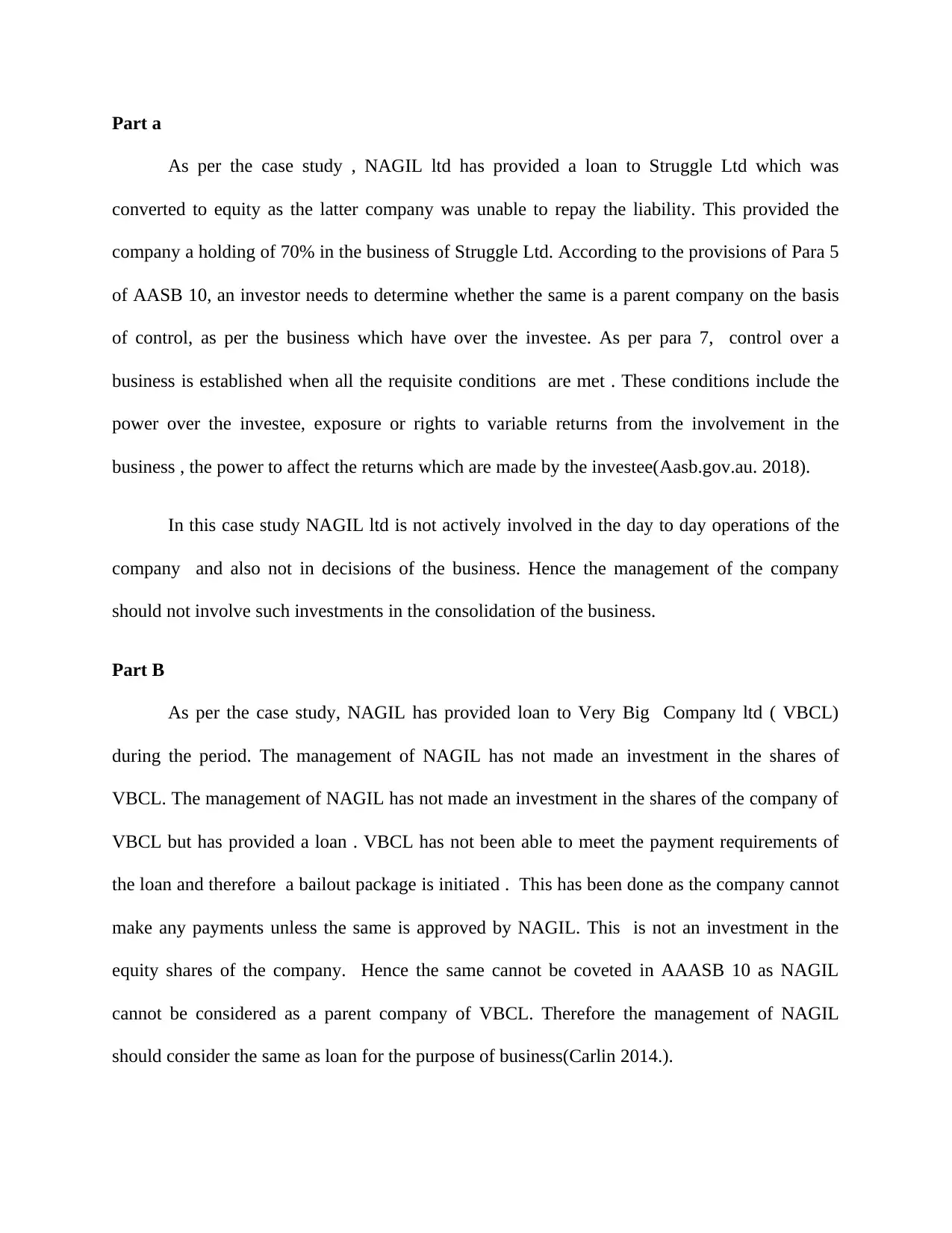
Part a
As per the case study , NAGIL ltd has provided a loan to Struggle Ltd which was
converted to equity as the latter company was unable to repay the liability. This provided the
company a holding of 70% in the business of Struggle Ltd. According to the provisions of Para 5
of AASB 10, an investor needs to determine whether the same is a parent company on the basis
of control, as per the business which have over the investee. As per para 7, control over a
business is established when all the requisite conditions are met . These conditions include the
power over the investee, exposure or rights to variable returns from the involvement in the
business , the power to affect the returns which are made by the investee(Aasb.gov.au. 2018).
In this case study NAGIL ltd is not actively involved in the day to day operations of the
company and also not in decisions of the business. Hence the management of the company
should not involve such investments in the consolidation of the business.
Part B
As per the case study, NAGIL has provided loan to Very Big Company ltd ( VBCL)
during the period. The management of NAGIL has not made an investment in the shares of
VBCL. The management of NAGIL has not made an investment in the shares of the company of
VBCL but has provided a loan . VBCL has not been able to meet the payment requirements of
the loan and therefore a bailout package is initiated . This has been done as the company cannot
make any payments unless the same is approved by NAGIL. This is not an investment in the
equity shares of the company. Hence the same cannot be coveted in AAASB 10 as NAGIL
cannot be considered as a parent company of VBCL. Therefore the management of NAGIL
should consider the same as loan for the purpose of business(Carlin 2014.).
As per the case study , NAGIL ltd has provided a loan to Struggle Ltd which was
converted to equity as the latter company was unable to repay the liability. This provided the
company a holding of 70% in the business of Struggle Ltd. According to the provisions of Para 5
of AASB 10, an investor needs to determine whether the same is a parent company on the basis
of control, as per the business which have over the investee. As per para 7, control over a
business is established when all the requisite conditions are met . These conditions include the
power over the investee, exposure or rights to variable returns from the involvement in the
business , the power to affect the returns which are made by the investee(Aasb.gov.au. 2018).
In this case study NAGIL ltd is not actively involved in the day to day operations of the
company and also not in decisions of the business. Hence the management of the company
should not involve such investments in the consolidation of the business.
Part B
As per the case study, NAGIL has provided loan to Very Big Company ltd ( VBCL)
during the period. The management of NAGIL has not made an investment in the shares of
VBCL. The management of NAGIL has not made an investment in the shares of the company of
VBCL but has provided a loan . VBCL has not been able to meet the payment requirements of
the loan and therefore a bailout package is initiated . This has been done as the company cannot
make any payments unless the same is approved by NAGIL. This is not an investment in the
equity shares of the company. Hence the same cannot be coveted in AAASB 10 as NAGIL
cannot be considered as a parent company of VBCL. Therefore the management of NAGIL
should consider the same as loan for the purpose of business(Carlin 2014.).
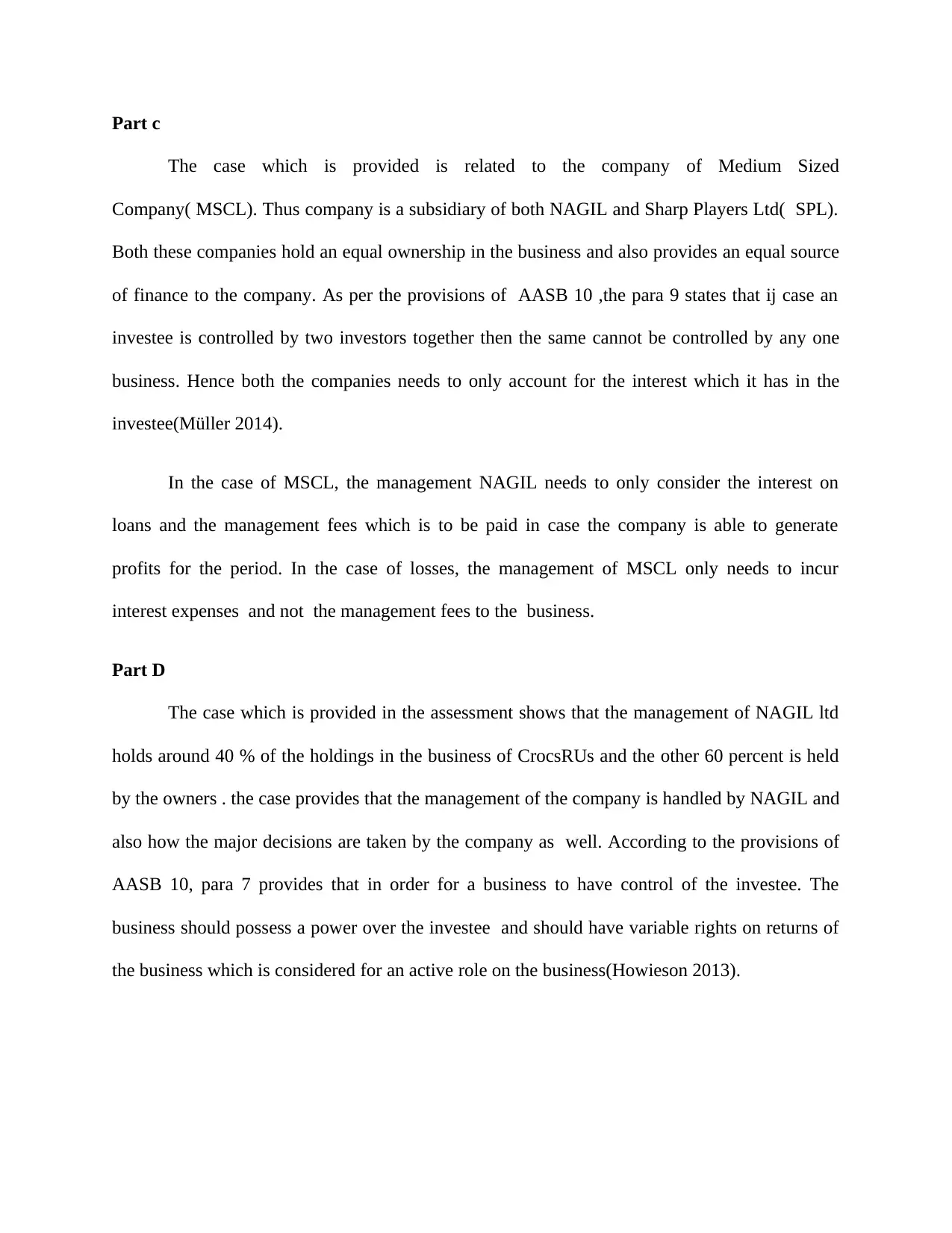
Part c
The case which is provided is related to the company of Medium Sized
Company( MSCL). Thus company is a subsidiary of both NAGIL and Sharp Players Ltd( SPL).
Both these companies hold an equal ownership in the business and also provides an equal source
of finance to the company. As per the provisions of AASB 10 ,the para 9 states that ij case an
investee is controlled by two investors together then the same cannot be controlled by any one
business. Hence both the companies needs to only account for the interest which it has in the
investee(Müller 2014).
In the case of MSCL, the management NAGIL needs to only consider the interest on
loans and the management fees which is to be paid in case the company is able to generate
profits for the period. In the case of losses, the management of MSCL only needs to incur
interest expenses and not the management fees to the business.
Part D
The case which is provided in the assessment shows that the management of NAGIL ltd
holds around 40 % of the holdings in the business of CrocsRUs and the other 60 percent is held
by the owners . the case provides that the management of the company is handled by NAGIL and
also how the major decisions are taken by the company as well. According to the provisions of
AASB 10, para 7 provides that in order for a business to have control of the investee. The
business should possess a power over the investee and should have variable rights on returns of
the business which is considered for an active role on the business(Howieson 2013).
The case which is provided is related to the company of Medium Sized
Company( MSCL). Thus company is a subsidiary of both NAGIL and Sharp Players Ltd( SPL).
Both these companies hold an equal ownership in the business and also provides an equal source
of finance to the company. As per the provisions of AASB 10 ,the para 9 states that ij case an
investee is controlled by two investors together then the same cannot be controlled by any one
business. Hence both the companies needs to only account for the interest which it has in the
investee(Müller 2014).
In the case of MSCL, the management NAGIL needs to only consider the interest on
loans and the management fees which is to be paid in case the company is able to generate
profits for the period. In the case of losses, the management of MSCL only needs to incur
interest expenses and not the management fees to the business.
Part D
The case which is provided in the assessment shows that the management of NAGIL ltd
holds around 40 % of the holdings in the business of CrocsRUs and the other 60 percent is held
by the owners . the case provides that the management of the company is handled by NAGIL and
also how the major decisions are taken by the company as well. According to the provisions of
AASB 10, para 7 provides that in order for a business to have control of the investee. The
business should possess a power over the investee and should have variable rights on returns of
the business which is considered for an active role on the business(Howieson 2013).
⊘ This is a preview!⊘
Do you want full access?
Subscribe today to unlock all pages.

Trusted by 1+ million students worldwide
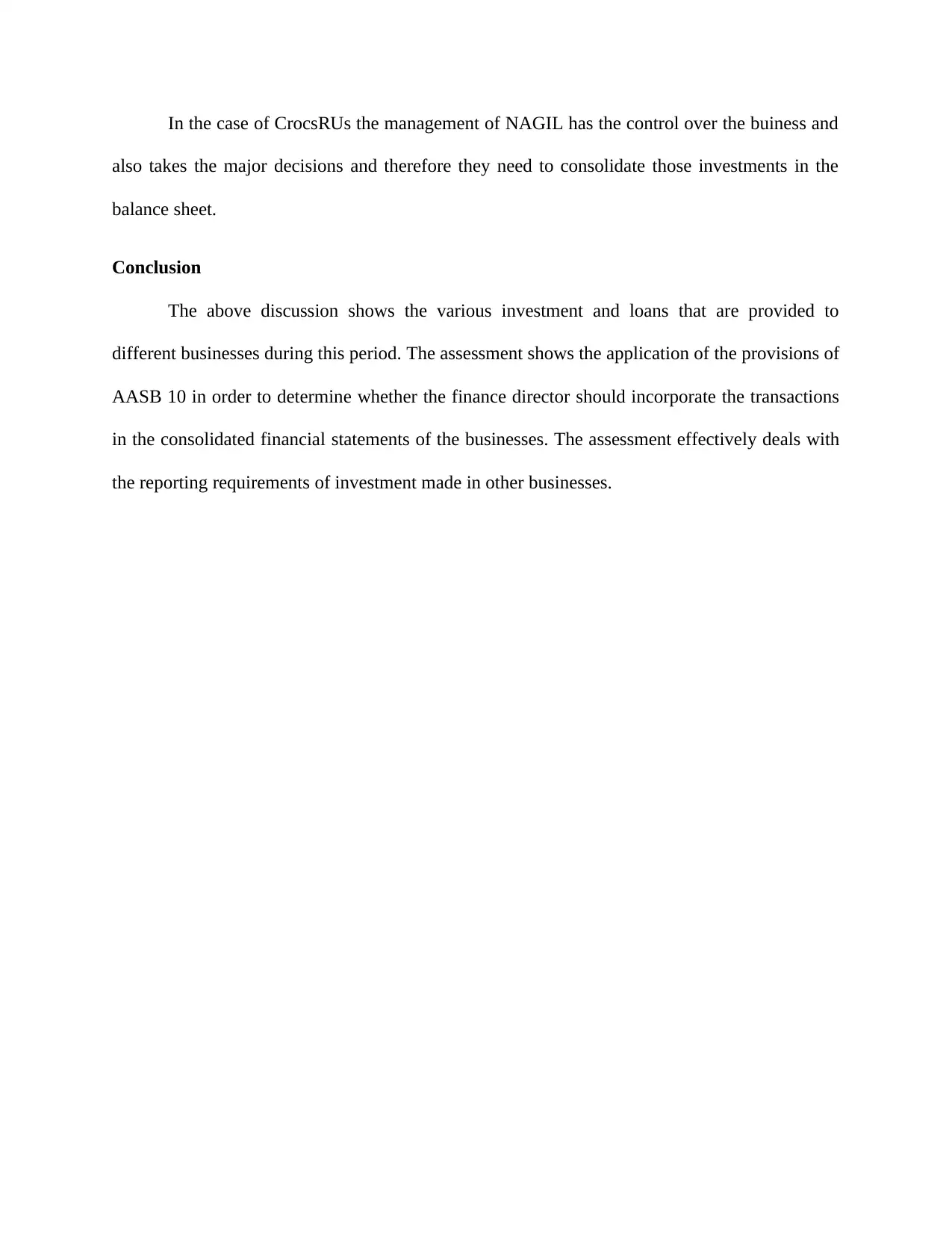
In the case of CrocsRUs the management of NAGIL has the control over the buiness and
also takes the major decisions and therefore they need to consolidate those investments in the
balance sheet.
Conclusion
The above discussion shows the various investment and loans that are provided to
different businesses during this period. The assessment shows the application of the provisions of
AASB 10 in order to determine whether the finance director should incorporate the transactions
in the consolidated financial statements of the businesses. The assessment effectively deals with
the reporting requirements of investment made in other businesses.
also takes the major decisions and therefore they need to consolidate those investments in the
balance sheet.
Conclusion
The above discussion shows the various investment and loans that are provided to
different businesses during this period. The assessment shows the application of the provisions of
AASB 10 in order to determine whether the finance director should incorporate the transactions
in the consolidated financial statements of the businesses. The assessment effectively deals with
the reporting requirements of investment made in other businesses.
Paraphrase This Document
Need a fresh take? Get an instant paraphrase of this document with our AI Paraphraser
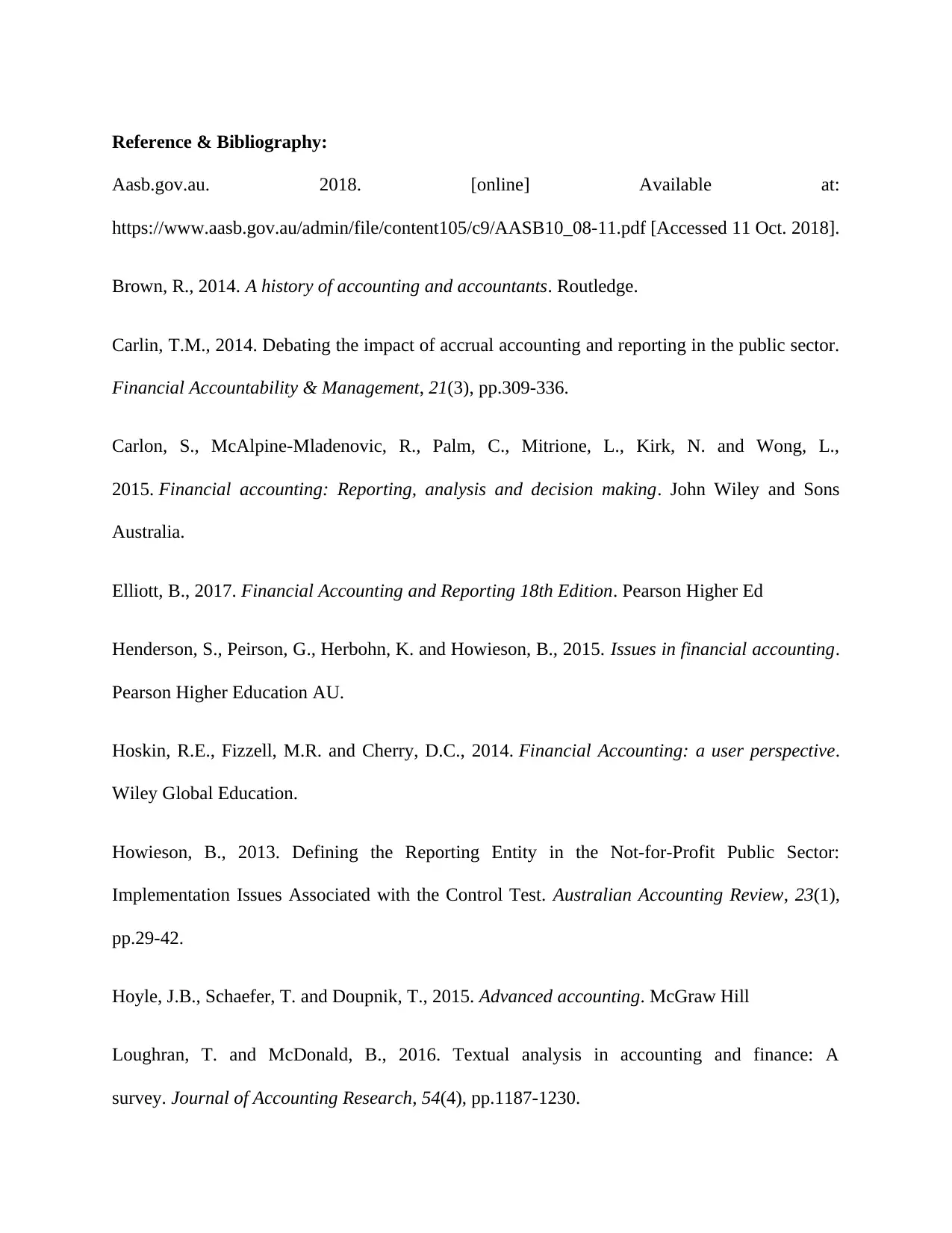
Reference & Bibliography:
Aasb.gov.au. 2018. [online] Available at:
https://www.aasb.gov.au/admin/file/content105/c9/AASB10_08-11.pdf [Accessed 11 Oct. 2018].
Brown, R., 2014. A history of accounting and accountants. Routledge.
Carlin, T.M., 2014. Debating the impact of accrual accounting and reporting in the public sector.
Financial Accountability & Management, 21(3), pp.309-336.
Carlon, S., McAlpine-Mladenovic, R., Palm, C., Mitrione, L., Kirk, N. and Wong, L.,
2015. Financial accounting: Reporting, analysis and decision making. John Wiley and Sons
Australia.
Elliott, B., 2017. Financial Accounting and Reporting 18th Edition. Pearson Higher Ed
Henderson, S., Peirson, G., Herbohn, K. and Howieson, B., 2015. Issues in financial accounting.
Pearson Higher Education AU.
Hoskin, R.E., Fizzell, M.R. and Cherry, D.C., 2014. Financial Accounting: a user perspective.
Wiley Global Education.
Howieson, B., 2013. Defining the Reporting Entity in the Not‐for‐Profit Public Sector:
Implementation Issues Associated with the Control Test. Australian Accounting Review, 23(1),
pp.29-42.
Hoyle, J.B., Schaefer, T. and Doupnik, T., 2015. Advanced accounting. McGraw Hill
Loughran, T. and McDonald, B., 2016. Textual analysis in accounting and finance: A
survey. Journal of Accounting Research, 54(4), pp.1187-1230.
Aasb.gov.au. 2018. [online] Available at:
https://www.aasb.gov.au/admin/file/content105/c9/AASB10_08-11.pdf [Accessed 11 Oct. 2018].
Brown, R., 2014. A history of accounting and accountants. Routledge.
Carlin, T.M., 2014. Debating the impact of accrual accounting and reporting in the public sector.
Financial Accountability & Management, 21(3), pp.309-336.
Carlon, S., McAlpine-Mladenovic, R., Palm, C., Mitrione, L., Kirk, N. and Wong, L.,
2015. Financial accounting: Reporting, analysis and decision making. John Wiley and Sons
Australia.
Elliott, B., 2017. Financial Accounting and Reporting 18th Edition. Pearson Higher Ed
Henderson, S., Peirson, G., Herbohn, K. and Howieson, B., 2015. Issues in financial accounting.
Pearson Higher Education AU.
Hoskin, R.E., Fizzell, M.R. and Cherry, D.C., 2014. Financial Accounting: a user perspective.
Wiley Global Education.
Howieson, B., 2013. Defining the Reporting Entity in the Not‐for‐Profit Public Sector:
Implementation Issues Associated with the Control Test. Australian Accounting Review, 23(1),
pp.29-42.
Hoyle, J.B., Schaefer, T. and Doupnik, T., 2015. Advanced accounting. McGraw Hill
Loughran, T. and McDonald, B., 2016. Textual analysis in accounting and finance: A
survey. Journal of Accounting Research, 54(4), pp.1187-1230.
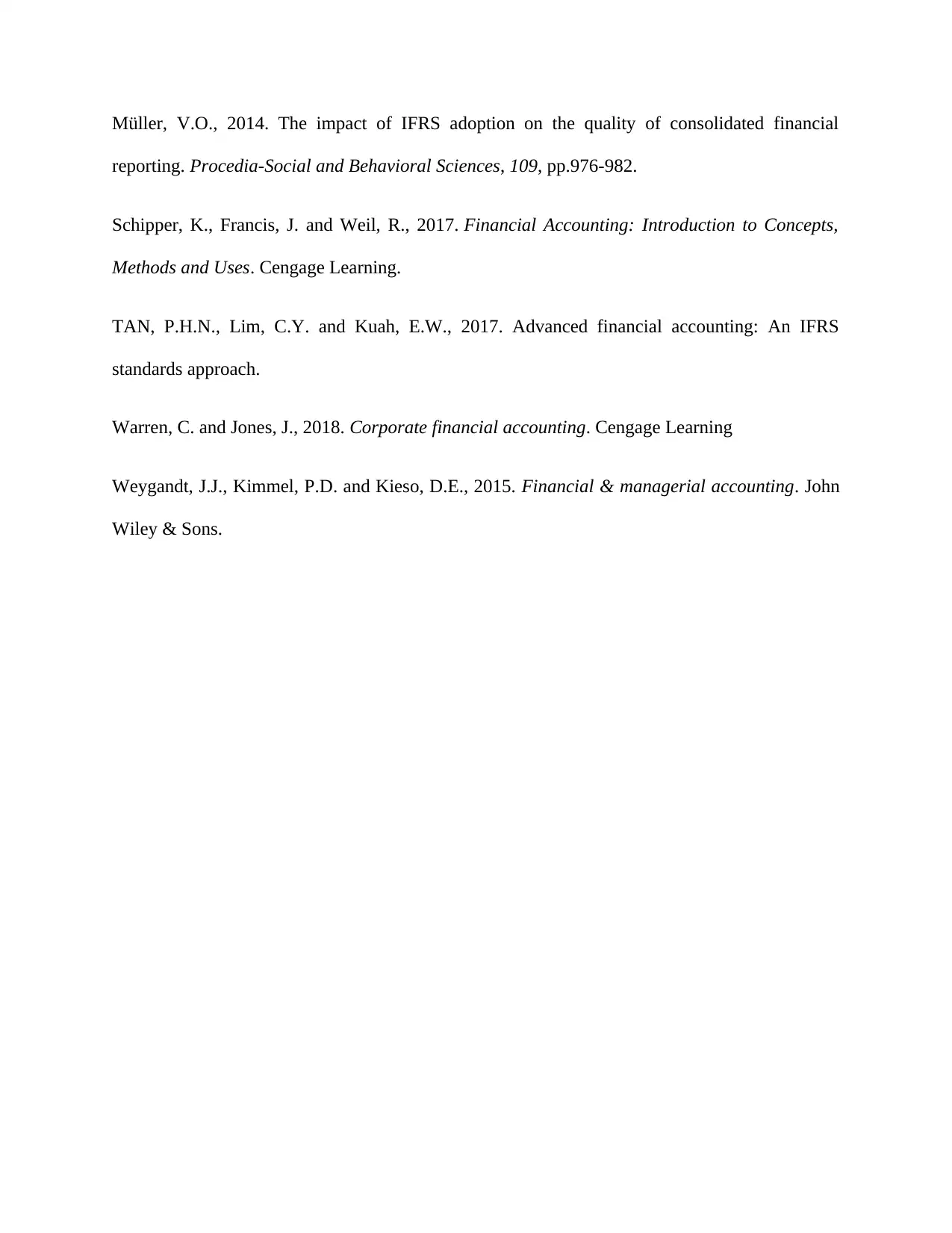
Müller, V.O., 2014. The impact of IFRS adoption on the quality of consolidated financial
reporting. Procedia-Social and Behavioral Sciences, 109, pp.976-982.
Schipper, K., Francis, J. and Weil, R., 2017. Financial Accounting: Introduction to Concepts,
Methods and Uses. Cengage Learning.
TAN, P.H.N., Lim, C.Y. and Kuah, E.W., 2017. Advanced financial accounting: An IFRS
standards approach.
Warren, C. and Jones, J., 2018. Corporate financial accounting. Cengage Learning
Weygandt, J.J., Kimmel, P.D. and Kieso, D.E., 2015. Financial & managerial accounting. John
Wiley & Sons.
reporting. Procedia-Social and Behavioral Sciences, 109, pp.976-982.
Schipper, K., Francis, J. and Weil, R., 2017. Financial Accounting: Introduction to Concepts,
Methods and Uses. Cengage Learning.
TAN, P.H.N., Lim, C.Y. and Kuah, E.W., 2017. Advanced financial accounting: An IFRS
standards approach.
Warren, C. and Jones, J., 2018. Corporate financial accounting. Cengage Learning
Weygandt, J.J., Kimmel, P.D. and Kieso, D.E., 2015. Financial & managerial accounting. John
Wiley & Sons.
⊘ This is a preview!⊘
Do you want full access?
Subscribe today to unlock all pages.

Trusted by 1+ million students worldwide
1 out of 12
Related Documents
Your All-in-One AI-Powered Toolkit for Academic Success.
+13062052269
info@desklib.com
Available 24*7 on WhatsApp / Email
![[object Object]](/_next/static/media/star-bottom.7253800d.svg)
Unlock your academic potential
Copyright © 2020–2025 A2Z Services. All Rights Reserved. Developed and managed by ZUCOL.





